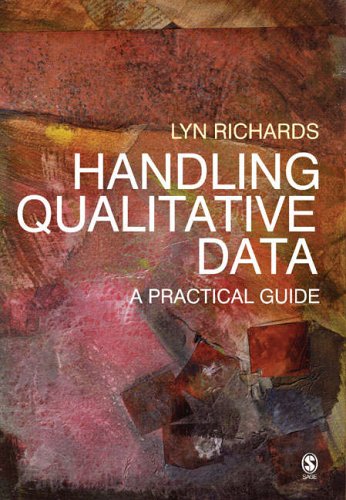Handling Qualitative Data : a Practical Guide
Richards, Lyn
Sage Publications, London
2005
0761942599
 Lyn Richards is well known for her involvement in the design of the qualitative data analysis software Nvivo/NUD*IST. This book is Richards' effort to address the problems that can occur when postgraduate students and researchers use such software and rapidly find themselves 'drowning in data' which the software has enabled them to store. Richards' approach is pragmatic, with the emphasis being upon making 'access and analysis [of data] achievable' (p.4). Whilst the book gives a nod of recognition to the theoretical concerns of different research paradigms, the primary concern is how to handle qualitative data effectively.
Lyn Richards is well known for her involvement in the design of the qualitative data analysis software Nvivo/NUD*IST. This book is Richards' effort to address the problems that can occur when postgraduate students and researchers use such software and rapidly find themselves 'drowning in data' which the software has enabled them to store. Richards' approach is pragmatic, with the emphasis being upon making 'access and analysis [of data] achievable' (p.4). Whilst the book gives a nod of recognition to the theoretical concerns of different research paradigms, the primary concern is how to handle qualitative data effectively.
The structure of the book is as would be expected for any applied text on the research process. Even if Richards' primary concern is handling data, it is made clear that planning how to handle data starts at the research design stage. The chapters logically follow the progression of a research project, from 'exploring' the data, to coding and analysis. What sets the text apart, however, is its straightforward and accessible style. Richards is never afraid to use a vivid analogy to illustrate a point, nor is she afraid to say in fifteen words what many authors would need fifty for. In a similar vein, the text is liberally sprinkled with examples from (fictitious, but highly plausible) qualitative research projects.
In my view, this book's real strength lies in its ability to make a qualitative research project seem 'do-able'. The impression that I took away was that Richards' own research projects have not necessarily been textbook-smooth, but that this has enabled her to write a text with a light touch that puts the reader at ease regarding the going back-and-forth of the research process. The book's style encourages the reader to 'dip in', and allows pressing practical concerns to be efficiently addressed. However, it also gently guides the reader towards substantive issues that he or she will need to address. Crucially, the text hands control of the research process back to the researcher. Richards highlights the importance of producing rigorous data and analyses, but also points out that rigour is established by a carefully crafted and recorded research process rather than an appeal to the tenets of any particular research paradigm (in particular, see the table on page 165, 'Seeing and testing synthesis and patterns').
The clarity of the book's structure also facilitates its utility as a reference text. In this respect, the schematic representations of each chapter's contents are a significant aid. Not only do they neatly summarize each chapter, but also the linkages between chapters and how these pertain to handling data. Similarly, the use of icons to highlight themes in the text is clear and useful; I can see the icon for 'teamwork' being of especial use to time-short researchers endeavouring to communicate the book's guidance to others.
This book could have just been a cheap advert for the Nvivo/NUD*IST software, but it is emphatically so much more than that. Reading it was a bit like having a (good!) doctoral supervision session – it requires active involvement if one is to get the most out of it, but is full of pithy advice. This is not to say that the use of qualitative data analysis software isn't promoted; the use of such a package is strongly integrated into the text, and an accompanying website provides useful tutorials for the Nvivo package. One message strikes home from the book, however; qualitative data analysis software is only a tool. It does not relieve the researcher of the craft aspect of data analysis and synthesis, but it can be a highly effective tool in the right hands. Richards' book provides an admirably concise and straightforward guide to utilising such a tool effectively.
Mark Pearson
University of Plymouth

